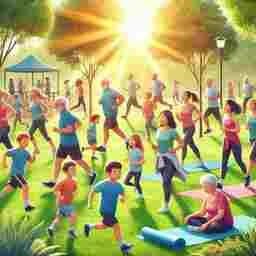Exercise for Overall Well-being: Best Tips for Every Age

When was the last time you thought about how exercise impacts your health? If it was this morning when you skipped your workout, you’re not alone! Whether you’re in your teens, 40s, or even 60s, regular physical activity plays a pivotal role in maintaining overall well-being. From boosting your mental health to reducing the risk of chronic diseases, exercise is like the magic pill we all need. But here’s the kicker—not all exercises are equally beneficial for every age group. What works for a 20-year-old might not be ideal for a 60-year-old. In this article, we’ll break down the best types of exercise for every age group, ensuring you stay fit and healthy no matter where you are in life.
Why Regular Exercise is Essential for Overall Well-being
Let’s start with the big picture: why is regular exercise such a game-changer for your overall well-being? First off, it’s not just about looking good or fitting into those old jeans (although that’s a nice bonus!). Exercise helps keep your heart healthy, reduces the risk of chronic diseases like diabetes and hypertension, and even improves mental clarity.
Research has shown that regular physical activity can lower the risk of heart disease by up to 35%, cut the risk of type 2 diabetes, and help manage weight. It’s also amazing for your mental health. Feeling stressed? A quick jog or yoga session can release endorphins, helping to elevate your mood and give you a sense of accomplishment.
But here’s the thing: to get the full range of benefits, you need to tailor your exercise routine to your age and physical condition. Let’s break down the best exercises for every stage of life.
Best Exercises for Children (Ages 5-12)
For kids, exercise is all about fun! Think back to your childhood—did you ever feel like you were “working out”? Probably not, but running around the playground, climbing trees, and playing tag all counted as physical activity. These kinds of activities are essential for kids because they help with growth, coordination, and motor skills.
Active play: Activities like tag, hide-and-seek, and running games are perfect for keeping kids moving.
Strength-building activities: Climbing on jungle gyms or doing gymnastics is great for building muscle in a natural way.
Sports: Encourage participation in team sports like soccer, basketball, or swimming, which help improve cardiovascular health while promoting teamwork.
The goal is to make exercise fun so that kids enjoy staying active. Ideally, children should get at least 60 minutes of moderate-to-vigorous physical activity each day.
Ideal Workouts for Teens and Young Adults (Ages 13-29)
Ah, the teenage years—a time of rapid growth and boundless energy! For teens and young adults, exercise isn’t just about staying fit; it’s about building healthy habits for life. This is the stage where endurance, flexibility, and strength all come into play.
Cardiovascular exercises: Running, swimming, and cycling are great for building stamina and improving heart health. Aim for at least 30 minutes of cardio, five times a week.
Strength training: Whether it’s lifting weights at the gym or doing bodyweight exercises like push-ups and squats, strength training is key for muscle development and bone health.
Yoga and Pilates: Flexibility and balance exercises like yoga or Pilates can help improve posture and reduce the risk of injury, especially for athletes.
One thing to keep in mind is that teens and young adults can sometimes push too hard, leading to overtraining and injuries. Make sure to balance intense workouts with recovery time.
Best Exercise Practices for Adults (Ages 30-49)
By the time you hit your 30s and 40s, life gets busy. Between work, family, and social commitments, it’s easy for fitness to fall by the wayside. But this is also a critical time to stay active because your metabolism starts to slow down, and muscle mass begins to decrease.
Weight-bearing exercises: These are vital to maintaining muscle mass and bone density. Incorporate exercises like lunges, squats, and deadlifts into your routine.
HIIT (High-Intensity Interval Training): Short bursts of intense activity followed by rest are efficient for calorie burning and boosting heart health. A 20-30 minute HIIT session can do wonders!
Stretching and mobility: As we age, our muscles and joints become stiffer. Regular stretching and mobility exercises help prevent injury and maintain flexibility.
Remember to focus on balance—too much intensity without proper recovery can lead to burnout. Aim for at least 150 minutes of moderate exercise or 75 minutes of vigorous activity per week, coupled with two strength-training sessions.
Safe and Effective Workouts for Seniors (Ages 50+)
As we age, our bodies naturally slow down, but that doesn’t mean we should give up on exercise. In fact, staying active in your 50s and beyond is crucial for maintaining independence, strength, and flexibility.
Low-impact cardio: Walking, swimming, or cycling are great ways to keep your heart healthy without putting too much strain on your joints. Aim for 30 minutes of cardio on most days of the week.
Strength training: Using resistance bands or light weights can help prevent muscle loss and improve balance. Even two sessions a week can make a difference.
Flexibility exercises: Stretching and flexibility work, like yoga or tai chi, can improve mobility and reduce the risk of falls.
The key is to start slow and increase intensity as your body allows. Even moderate activity can lead to significant improvements in strength, balance, and overall health.
Conclusion
No matter your age, regular exercise is one of the most powerful tools you can use to improve your overall well-being. The right type of physical activity can boost your mental health, improve your body’s functionality, and enhance your quality of life. Remember, the key is to choose exercises that fit your age and body’s needs—what’s good for one age group may not be suitable for another. So, whether you’re starting out young, in your prime, or enjoying your golden years, make a habit of moving! Not sure where to begin? Start small, stay consistent, and feel the difference. Ready to get moving? Let’s go!




13 thoughts on “Exercise for Overall Well-being: Best Tips for Every Age”